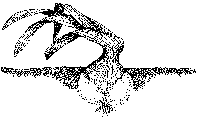 Introduction
Introduction
 Causes of Plant
Damage
Causes of Plant
Damage
 Use a Systematic
Approach
Use a Systematic
Approach
 Double-Check the
Obvious
Double-Check the
Obvious
Diagnosis of plant problems is often a difficult task. There
can be many different causes for a given symptom, not all of them related to
insects or diseases. Soil nutrition and texture, weather conditions, quantity of
light, and other environmental and cultural conditions influence the health of a
plant.
The most effective approach is to know what questions to ask to narrow down
the possibilities. For example, you need to consider recent rainfall and
fertilization schedule if you notice brown, dry edges on the leaves of your
plants since both dry weather and excess fertilizer can cause such damage. As
another example, both excessively dry soil or waterlogged soil can cause the
same plant reaction - wilt. Even insect damage can sometimes be confused with
plant diseases caused by microorganisms.
Return to Table of Contents
Factors causing plant damage can be grouped into two major categories. Living
factors include pests (insects, mites, rodents, rabbits, deer) and pathogens
(disease causing microorganisms, including fungi, bacteria, viruses, nematodes).
Non-living factors include mechanical factors (breakage, abrasions),
environmental factors (temperature, light, moisture, oxygen, lightning, wind),
and chemical factors (fertilizer or pesticide excess, nutritional disorders).
Return to Table of Contents
Define the problem. Closely examine the entire plant and others around
it. Take note of all the symptoms. For example, if the plant has insects,
examine the leaves with insects on them; do they have brown spots, holes, chewed
edges? Are they turning pale green or yellow? Is there more than one kind of
insect present?
Look for patterns. Do other plants have the same problem? Are they all
in the same place or in different locations? Are they all the same type of
plant? Damage to all different types of plants in a particular spot can indicate
non-living factors. Damage to a few species of plants or only to plants of the
same species can indicate living factors.
Examine spread of problem. Is the problem spreading gradually? This
can indicate living factors. If the problem occurred suddenly and remains in a
particular spot or on a particular plant, this points toward non-living factors.
Determine likely cause of damage. Based on the pattern and spread,
decide if the problem is more likely caused by living factors or non-living
factors. If living, is the problem a pathogen or a pest?
Return to Table of Contents
If disease is a possibility, check the following general guidelines for
identifying the different causes of disease:
 A fungal pathogen often causes
round leaf spots, stem rots with a dry/papery texture, concentric rings,
discoloration, or wilt. Fruiting structures (sometimes microscopic) may form on
affected tissue.
A fungal pathogen often causes
round leaf spots, stem rots with a dry/papery texture, concentric rings,
discoloration, or wilt. Fruiting structures (sometimes microscopic) may form on
affected tissue.
A bacterial disease can take the form of galls (swollen areas),
irregularly shaped leaf spots, wilting (then yellowing and dying), or rot (often
a wet rot).
 A viral pathogen can inhibit
chlorophyll formation, causing degrees of yellowing or mottling, stunting,
distortion, or dieback of part of the plant. Viruses usually debilitate rather
than kill, as they are parasitic.
A viral pathogen can inhibit
chlorophyll formation, causing degrees of yellowing or mottling, stunting,
distortion, or dieback of part of the plant. Viruses usually debilitate rather
than kill, as they are parasitic.
Nematodes are microscopic roundworms that cause disease-like symptoms.
Stem nematodes feed on stems and cause shortening of internodes. Root nematodes
feed underground, damaging the root system; this leads to moisture and nutrient
stress which shows up as wilting and stunting. Foliar nematodes cause angular
leaf spots.
If an insect problem seems likely, check the following:
A chewing/rasping insect feeds on plant tissue and can cause
ragged/chewed or missing leaves (caterpillars, slugs, beetles, grasshoppers),
rolled leaves (leafroller), tunnels in between upper and lower leaf surfaces
(leaf miners), holes in stems, branches or trunk; sections of tree dying; or
premature yellowing (wood borers), girdled or dead stems (cutworms, twig
girdlers, or stem borers), or general decline of plants due to root damage (soil
dwelling insects)

 A
sucking insect feeds on plant fluids and injects toxins into the plant. The
toxins can cause leaf spotting or stippling (aphids, leafhoppers, spider mites,
other bugs), leaf distortion such as curling or puckering (or more commonly this
can be damage from leafhoppers and thrips), or poisoning of entire plants,
resulting in stunted growth and/or yellowing (scale, mealybugs, mites, aphids,
whitefly).
A
sucking insect feeds on plant fluids and injects toxins into the plant. The
toxins can cause leaf spotting or stippling (aphids, leafhoppers, spider mites,
other bugs), leaf distortion such as curling or puckering (or more commonly this
can be damage from leafhoppers and thrips), or poisoning of entire plants,
resulting in stunted growth and/or yellowing (scale, mealybugs, mites, aphids,
whitefly).
Return to Table of Contents
Damage caused by mechanical factors is usually revealed by close
visual examination; check for broken or girdled stems or roots, also bruised,
punctured, or broken leaves.
Damage due to physical factors often results from environmental
extremes. Cold damage is characterized by death of exposed foliage. Container
plants are susceptible to cold damage to the root system, characterized by
blackened or spongy roots with lack of new growth or root hairs, usually near
the container edge.
A rapid change from low light to high light intensity, or vice versa,
can cause yellowing of leaves, reduced growth, and leaf drop or death. Too
little light can reduce, delay, or prevent flowering.
Excess heat usually causes scorch symptoms on leaf tips and
interveinal areas. Portions of leaves shaded by other leaves, or leaves on the
shady side of the plant, may be undamaged. Frequently, heat damage will occur
uniformly over all plants in an affected area.
Drought and waterlogging produce many of the same symptoms on the
above-ground parts of the plant, mainly chlorosis (yellowing leaves), abscission
(shedding older leaves), and wilt. Waterlogging of the root zone also results in
oxygen deficiency, leading to a halt in root growth and metabolism, death of the
roots, and wilt.
Damage due to chemical factors - inappropriately used pesticides or
excessive rates of pesticides can cause symptoms, such as leaf burn, distortion,
chlorosis, or bleaching, depending on the chemical. On a field basis, pesticide
or fertilizer damage symptoms frequently are associated with application
patterns.
 Nutrient deficiencies show up as
yellowing, stunting, or death of older plant leaves or new growth, depending on
the missing nutrients.
Nutrient deficiencies show up as
yellowing, stunting, or death of older plant leaves or new growth, depending on
the missing nutrients.
Refer to expert information. Talk to your Extension agent or local
garden center, explaining the symptoms thoroughly, or check all the symptoms
against a good chart or reference book, keeping in mind the factor you have
determined as the likely cause. If it appears insects or pathogens are causing
the problem, be sure to positively identify the pest so you can choose the most
effective control measure.
Return to Table of Contents
It never hurts to look again for obvious problems. is the stem/trunk badly
damaged? Has the plant been sitting in a saucer of water for a week? Has your
neighbor sprayed weedkiller lately? Does your cat enjoy fern salad? Is your dog
deprived of fire hydrants? Do your children "help" you by cleaning the plants
with furniture polish or window cleaner?
Return to Table of Contents
![]() Gardeners' Corner
Kids'
Garden
Sustainable Garden
Contact Us
Gardeners' Corner
Kids'
Garden
Sustainable Garden
Contact Us![]()




 A fungal pathogen often causes
round leaf spots, stem rots with a dry/papery texture, concentric rings,
discoloration, or wilt. Fruiting structures (sometimes microscopic) may form on
affected tissue.
A fungal pathogen often causes
round leaf spots, stem rots with a dry/papery texture, concentric rings,
discoloration, or wilt. Fruiting structures (sometimes microscopic) may form on
affected tissue.  A viral pathogen can inhibit
chlorophyll formation, causing degrees of yellowing or mottling, stunting,
distortion, or dieback of part of the plant. Viruses usually debilitate rather
than kill, as they are parasitic.
A viral pathogen can inhibit
chlorophyll formation, causing degrees of yellowing or mottling, stunting,
distortion, or dieback of part of the plant. Viruses usually debilitate rather
than kill, as they are parasitic. 
 A
sucking insect feeds on plant fluids and injects toxins into the plant. The
toxins can cause leaf spotting or stippling (aphids, leafhoppers, spider mites,
other bugs), leaf distortion such as curling or puckering (or more commonly this
can be damage from leafhoppers and thrips), or poisoning of entire plants,
resulting in stunted growth and/or yellowing (scale, mealybugs, mites, aphids,
whitefly).
A
sucking insect feeds on plant fluids and injects toxins into the plant. The
toxins can cause leaf spotting or stippling (aphids, leafhoppers, spider mites,
other bugs), leaf distortion such as curling or puckering (or more commonly this
can be damage from leafhoppers and thrips), or poisoning of entire plants,
resulting in stunted growth and/or yellowing (scale, mealybugs, mites, aphids,
whitefly).  Nutrient deficiencies show up as
yellowing, stunting, or death of older plant leaves or new growth, depending on
the missing nutrients.
Nutrient deficiencies show up as
yellowing, stunting, or death of older plant leaves or new growth, depending on
the missing nutrients.